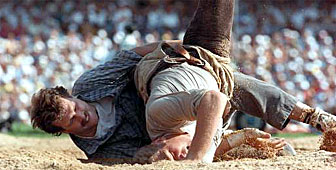Swiss wrestling prepares for big weekend

Nearly 300 of the beefiest men in Switzerland will attempt to become king of Swiss-style wrestling over the coming weekend at the Federal Wrestling Festival in Nyon. Here's a brief guide for the uninitiated.
The Federal Wrestling Festival is held once every three years, and to be crowned king is the pinnacle of a Swiss wrestler’s career.
“Swiss-style wrestling is a typically Swiss sport, and has its origins in alpine culture,” explains Remy Lambelet, vice-president of the Nyon 2001 organising committee and president of canton Vaud’s Wrestling Association.
“It is only practiced in Switzerland or by Swiss living abroad,” he told swissinfo. In fact wrestlers are coming to Nyon from as far afield as the United States, Canada, Australia and South Africa.
The contests are held on a large circle of sawdust, 14 metres in diameter. Wrestlers compete in ordinary clothes, over which they wear distinctive sack shorts.
But the clothes reveal something about the wrestlers, who belong to two distinctive groups. The farmers, or Sennen, wear dark trousers and colourful – often light blue – shirts, and the Turner, from the gymnastic clubs, can be distinguished by their all-white clothing.
Size not everything
The sack shorts, worn over the men’s normal working clothes, were introduced to prevent their trousers and shirts from getting ripped, and were then incorporated into the rules.
“You must keep one hand on your opponent’s shorts at all times, otherwise the fight is stopped,” Lambelet says.
Traditionally, Swiss wrestling, also known as schwingen, was practised by big farm boys, but nowadays, participants come from all walks of life. And while most of them cut imposing figures, size is not everything. Technique is just as important as brute strength.
Over the centuries, schwingen has developed a dazzling array of holds and moves, many of which, like the Brienzer, bear the names of the places where they originated. All have one aim: “You have to get both your opponent’s shoulders on the ground to win the contest,” Lambelet says.
Winning the bout is not always enough to progress, however. Moving on to the later rounds also depends on receiving points for the quality of the moves and throws executed.
Fair-play
Schwingen prides itself on its sportsmanship, and this is best seen in the ritual that follows every bout. After a firm handshake, the winner brushes the sawdust from the back of his adversary.
“In wrestling, we are enemies for five minutes but friends forever,” Remy Lambelet says. “Fair-play is the foundation on which Swiss wrestling is built.”
Lambelet is proof that schwingen has moved beyond its traditional heartland of the mountain pastures of central and eastern Switzerland, although German-speaking clubs are still the strongest.
“It was born in the Alps, but we are all part of the same confederation. Now there are wrestlers throughout the country,” Lambelet says.
Even so, schwingen is closely tied up with the traditions of the mountain meadows where it was born. It is inextricably linked in many people’s minds with alphorns, yodelling and dairy farming, and many boys take up the sport out of a sense of patriotism.
Serious sport
“For many, this only has a folkloric aspect. But there is also an athletic aspect. This is a serious sport,” says Claude Ruey, the cantonal minister who heads the Nyon 2001 organising committee.
“Not just anyone can come and take part. The 280 wrestlers who take part in the federal festival have had to go through a rigorous qualification process,” he told swissinfo.
Those who have made it to Nyon will be taking it very seriously, but schwingen is not a professional sport. In keeping with its farming origins, the prizes are agricultural: the king of Swiss wrestling traditionally gets to take home a prize bull.
Jörg Abderhalden from St Gallen, who won the last Federal Festival in Berne in 1998 as a 19-year-old, is once again among the favourites, along with the likes of Arnold Forrer, from Toggenburg, and Heinz Suter, from Muothatal in Central Switzerland.
by Roy Probert

In compliance with the JTI standards
More: SWI swissinfo.ch certified by the Journalism Trust Initiative
You can find an overview of ongoing debates with our journalists here. Please join us!
If you want to start a conversation about a topic raised in this article or want to report factual errors, email us at english@swissinfo.ch.